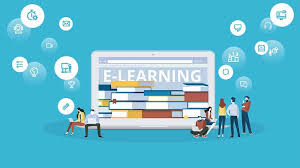Why E-Learning?E-Learning delivers more training to more people for the fewest dollars. It’s flexible, fast, and convenient. It saves time, money, and resources. And it delivers measurable, tangible results. Today’s world is driven by access, information, and speed. The key to success is moving knowledge from the people who have it to the people who need it. E-Learning gives you the power to do exactly that. Virtually anyone can sharpen their skills or develop new ones, pick up quick tips or launch a whole new career, earn an IT certification or enhance business skills through e-learning. The possibilities are just beginning.
Features of E-Learning
• Learning is self-paced and gives students a chance to speed up or slow down as necessary
• Learning is self-directed, allowing students to choose content and tools appropriate to their differing interests, needs, and skill levels
• Designed around the learner
• Geographical barriers are eliminated, opening up broader education options
• On-demand access means learning can happen precisely when needed
• Travel time and associated costs (parking, fuel, vehicle maintenance) are reduced or eliminated
• Overall student costs are frequently less (tuition, residence, food, child care)
• Potentially lower costs for companies needing training, and for the providers
• Enhances computer and Internet skills
• Draws upon hundreds of years of established pedagogical principles
• Has the attention of every major university in the world, most with their own online degrees, certificates, and individual courses
Some of the key benefits of e-Learning include:
• E-Learning means that you no longer need to spend long periods travelling to a location to attend a course; you can now have access to learning when you want it, at the time you want it – day or night, wherever you want it. For many students this has opened up a new, much more flexible and accessible world of learning that was previously closed to them due to disability or family circumstances, or perhaps due to the fact that the course they wanted was on the other side of the world.
• E-Learning can make learning exciting, engaging and compelling. Hard and boring subjects can be made easier, more interesting and appealing with e-learning.
• Learning is a social activity, and e-learning means that powerful and enduring learning experiences can be achieved, not just through content, but through the use of online communities and networks. Here learners are encouraged to communicate, collaborate and share knowledge. In this way, e-Learning can support “learning through reflection and discussion”.
• Learning has moved from the classroom onto the desktop and now into the pocket. It’s a fact that we are all becoming more mobile. The term m-learning is used to describe the use of PDAs and mobile phones for learning. PDAs are very useful devices onto which learners can download learning content and then view it at their convenience.
• E-Learning empowers learners to manage their own learning and in the most appropriate way for each learner. We all learn in different ways – reading, watching, exploring, researching, interacting, doing, communicating, collaborating, discussing, sharing knowledge and experiences.
• E-Learning is also helping to embed learning within work processes, as organisations begin to recognise that learning is not something that only takes place in a classroom. In fact, 70% of all learning occurs while a person is on the job, that is, not in formal training or education but in everyday working life as employees carry out their jobs – finding out information, reading documents, talking to other colleagues etc. It is these kinds of informal learning activities that e-learning can also support and encourage within an organization.
• E-Learning has helped organisations with their bottom line. Many organisations have reported improved time to develop competencies and this reduction in learning time has meant savings on salaries and opportunity costs, and increased customer and staff satisfaction has led to higher customer and staff retention rates.







